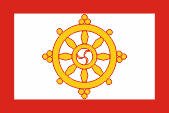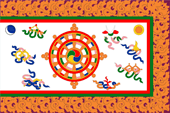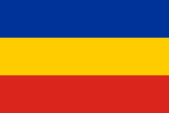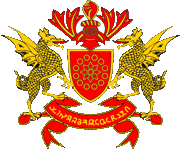mobile View, to the German Version tap the flag


- to 1975 with India associated Kingdom
- since 1975 federal state of India
- other names:
Tibetan: Depjong, Demjong, Denjong
Chinese: Che Meng Hsiung
• Flags
• Meaning/Origin of the Flag
• Coat of Arms
• Meaning/Origin of the Coat of Arms
• Map
• Numbers and Facts
• History
• Origin of the Country's Name

1967–1975,
State flag and flag of the Maharajah,
ratio = 2:3,
Source, by: Flags of the World




1877–1967,
State flag and flag of the Maharajah,
Source, by: Flags of the World




since 1993,
Flag of the Sikkim Democratic Front,
Source, by: Flags of the World




Central element of the flag of Sikkim was the "Chakra", the Bhuddist "Wheel of Doctrine". It points out to the first sermon of Buddha near Benares Town, which was described as the "Turning on the Wheel of Doctrine". Other sources tell that the wheel in de flag is a prayer wheel, a so-named "Khorlo". The until 1967 valid flag showed a very abundant designing with a copious border and next to the "Chakra" some religious pictograms. Probably was adoped a more simply design in 1967 because of the very difficult duplication. The border became single-coloured red, the pictograms were removed and the wheel was redesigned. With the joining of Sikkim to the Republic of India and with the abolition of the monarchy the flag was also abolished. Sikkim has in this way none own flag anymore. In the year 1994 the nationalist party of the Democratic Front of Sikkim came into power and accordingly thinking citizens use since them its party-flag like a national symbol.
Source:
Wikipedia (DE), Flags of the World


Coat of arms of Sikkim,
Source, by: royalark.net

The coat of arms of Sikkim shows a red golden surrounded shield. On the shield a circle of twelve golden rings and in it a stylized red and golden surrounded eight-pointed star. Above the shield a red helmet with a golden visor, red-golden torus and red-golden blankets. Upon the helmet a red-golden rosebud. Supporters of the shield are two golden dragons. Below the shield and a red banner with the name of the country. The colours red and gold are probably the colours of the house of Namgyal which ruled the country between 1641 and 1975. The colours red and yellow could also point out to the orders of the Tibetan red and yellow lamas. The red lamas enthroned in 1641 the first Namgyal-King. The both dragons are symbols of luck. The coat of arms is still used in a similar form by the government of Sikkim, although no federal state in India – except the former Jammu and Kashmir – is allowed to have its own coat of arms or flag.
Source:
Wikipedia (EN), royalark.net

Location:

Area: 2.740 square miles
Inhabitants: 610.577 (2011), thereof 62% Nepalese, 9% Gurkha (Hindu-Nepalese), 7% Buthia (Tibetan), 6% Lepcha (Sikkimese)
Religions: 58% Hindu, 27% Buddhist, 10% Christian, 2% Muslim
Density of Population: 223 inh./sq.mi.
Capital: Gangtok, 100.290 inh. (2011)
official Languages: Nepali, Bhutia, Lepcha, English
other Languages: Gurung, Limbu, Magar, Mukhia, Newari, Rai, Sherpa, Tamang, Hindi
Currency: Indian currency
Time Zone: GMT + 5,5 h
Source: 1) Wikipedia (EN), 2) Wikipedia (EN)

13th century · settlement by the people of Rong (later named Lepcha by the Nepalese), nascence of diverse Rong-Principalities
15th century · immigration of the Buthia (Tibetans), introduction of Buddhism
1641 · The Tibetan dynasty of Namgyal establishes with king Phuntsok Namgyal in the place Yuksom the reign in the Kingdom of Sikkim under Chinese supremacy
1670 · the capital becomes transfered to Rabdentse
1700 · invasion of Bhutanese troops
1710 · restoration of the sovereignty of Sikkim by Tibetan troops
1710–1788 · phase of frequent rides of Bhutanese and especially of Nepalese troops, the capital Rabdentse becomes ruined
1788 · the king flees to Tibet
1791 · Chinese and Tibetan troops invade Nepal to protect Tibet and Sikkim, Nepal comes under Chinese supremacy, but Sikkim has to cede some territories to Nepal, the king returns under protection of Tibetan and Bhutanese troops to Sikkim, Sikkim contacts to its own protection against Nepal to the since 1765 in the neighbouring Province of Bengalen present British (British East India Company)
1813 · once more invasion of Nepalese troops, Sikkim becomes overruned, but the king is able to withstand in Gangtok Town
1814 · the Gurkha War of the British East India Company against Nepal ends with the defeat of Nepal
1817 · Treaty of Titalia between Sikkim and British India, Sikkim becomes a vassal state of British India under British supremacy
1817 · Treaty of Sugauli between Sikkim and Nepal, Nepal cedes back to Sikkim the in 1791 earned territories
1835 · invasion of British troops, the dynasty of Namgyal stands on the throne but becomes displaced from the power by the appointment of a British governor, Sikkim has to cede the district of Darjeeling to British India
1849 · Sikkim has to cede the district of Morang to British India
1889 · appointment of a British regent for Sikkim
1890 · China recognizes the British supremacy over Sikkim, Nepalese immigrate in large numbers and become employed in the tea-plantations
1892 · the king is unable to withstand the pressure of the British and flees to Tibet
1893 · Tibet intends the restoration of the kingship in Sikkim and sends the king back to Sikkim, the king flees to British India
1895 · the king returns because of British wishes back to Sikkim and takes over his function without restrictions, the royalty becomes fully restored but Sikkim stands a British protectorate and has to accept the British supremacy
15th of August 1947 · India becomes independent, the protectorate over Sikkim becomes formally transfered from United Kingdom to India
1949 · Indian troops suppress a revolt
5th of December 1950 · Treaty of Gangtok, renewal of the Indian protectorate, in Gangtok becomes installed an Indian regent for Sikkim and Bhutan
1970–1974 · violent ethnic conflicts in Sikkim, intervention of the Indian army
1974 · Sikkim becomes an associated state of India
10th of April 1975 · the king becomes deposed because of Indian influence
16th of May 1975 · referendum, Sikkim becomes the 22nd federal state of India, the monarchy becomes abolished
2003 · China recognizes Sikkim as a part of India
Source: Atlas zur Geschichte,
Wikipedia (DE),
royalark.net,
World Statesmen

The name "Sikkim" has its roots in the Limboo-Language. It is composed by the words "Su" standing for "new" and "Khyim" standing for "palace". Sikkim is in this way the "New Palace". In the Tibetan languages Sikkim is called "Depjong", "Demjong" or even "Denjong", in Chinese language "Che Meng Hsiung". The pristine people of Sikkim are the Rong. In Nepalese they are called "Lepcha", what means "cairn". Because of the potent Nepalese immigration since 1890 are the Rong meanwhile a national minority, what causes again and again ethnic conflicts.
Source: royalark.net, Volker Preuß


Kindly supported by: Wpantemister
![]()











